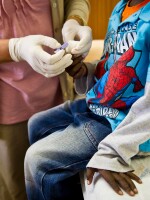A 4-year-old child who died of a rare brain infection in early August has led Louisiana health officials to discover that the cause is lurking in the water pipes of St. Bernard Parish, southeast of New Orleans.
It's a type of single-celled amoeba called Naegleria fowleri, about a tenth the width of a human hair. Some call it a "brain-eating" amoeba, although it does its damage by causing a devastating immune reaction rather than by actually devouring brain tissue.
Officials are pumping more chlorine into the municipal water supply to kill the bugs and advising the parish's 40,000 residents how to avoid infection. They say the risk is tiny.
As we'll discuss shortly, it's not easy to get infected, and drinking the water poses no risk. But still, finding such a dangerous microbe in the drinking water is troubling and noteworthy.
"This is the first time that it has been found in the drinking water in the United States," Louisiana state epidemiologist Raoult Ratard tells Shots.
But it won't be the last, he says — because health officials are now trying to pin down the cause of previously unexplained encephalitis cases. About 40 percent of cases of this dangerous brain inflammation have no known cause. "Five years ago, we would never have known that this recent case was caused by the amoeba," Ratard says.
Another new element: The Centers for Disease Control and Prevention now tests water supplies when a case of amoebic encephalitis is discovered, to see where the bug came from.
For instance, in 2011 two Louisiana residents — one a 20-year-old man from St. Bernard Parish — died of amoebic encephalitis after using tap water to rinse their nasal passages, using a popular device called a neti pot. Health officials assumed that contaminated tap water was the source of the infection, but it was never proved.
This summer the amoeba infected the brains of two other US children – a 12-year-old Florida boy, who died, and a 12-year-old Arkansas girl, who survived. She may be one of only three known to survive the infection in the United States.
These alarming deaths are likely to remain rare – but not quite as rare as health officials used to think.
"We're going to see more cases," Ratard says. Instead of three to five cases of amoebic encephalitis per year across the nation, "maybe we'll go to 10 a year," he says. "I don't expect we'll have a hundred."
The episode vividly illustrates how humans live in a sea of potentially lethal microbes that, amazingly, seldom kill.
In this case, it's because Naegleria fowleri is only dangerous when it gains entry into the brain. It does that when water containing the amoeba gets inhaled very deeply, into the area where the roof of the nasal passages meets the floor of the brain.
"To get infected, the amoeba has to get to the ceiling of your nose – way, way up there," Ratard says. "At the top of the nose you have a little paper-thin plate made of bone with a bunch of holes, a little bit like a mosquito net. The holes are for the olfactory nerve. So the amoeba is crawling up the nerve and gets into the brain."
Drinking amoeba-contaminated water poses no risk, presumably because the single-celled organisms can't survive in stomach acid. Normal bathing or showering isn't a risk because even if tap water is contaminated, it doesn't penetrate into the deepest nasal passages.
Brain infections from the amoeba usually pop up in late summer, when warm water favors its reproduction and many people are diving into ponds to escape the heat.
Since uncounted numbers of people swim in waters that undoubtedly contain amoebae, Ratard says, it's a wonder there aren't more infections. Public swimming pools pose no risk because chlorine kills the microbes.
The child who died last month in St. Bernard Parish while visiting from Mississippi, had been playing a long time on a Slip'n'Slide connected to a household water faucet.
It took about two weeks for the CDC to determine that the child had a Naegleria fowleri infection. Then state officials started investigating how.
"We collected the hose and got some samples from the outside faucet, water heater, and toilet tank water," Ratard says. After testing verified amoeba contamination, Louisiana officials put out a press release about the case.
Further testing of tap water in four nearby areas revealed the presence of Naegleria fowleri, as officials announced on Thursday.
Understandably, the announcement has sparked considerable local anxiety, even though health officials have stressed that the risk is low – and can be avoided entirely by common-sense precautions.
"In the old days, you would look at your faucet and it wouldn't scare you," Ratard says. "But these days, for some people, it looks menacing."
To avoid risk, officials are advising people not to put their heads under water while bathing in tap water — and to supervise young children who might. Flushing the water from household pipes before filling a child's wading pool decreases the risk, although some people might want to add some bleach to the water as an added precaution.
Local officials have shut off the water at school drinking fountains, although it's hard to imagine how schoolchildren could inject that water deep into their noses.
In a couple of weeks, officials will retest the St. Bernard Parish drinking water to ensure that added chlorine has eliminated the threat – for this season at least.
Copyright 2020 NPR. To see more, visit https://www.npr.org.



